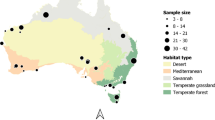Summary
The ecological consequence of the effects of different social conditions on the behaviour of females with infants were examined in two different-sized groups of long-tailed macaques (Macaca fascicularis) that inhabited adjacent home ranges in Gunung Leuser National Park in Indonesia. This study aims to test predictions of the “within-group competition/predation avoidance” hypothesis of social organization. Females, particularly those carrying an infant, are considered to experience the most direct effects of environmental constraints on fitness prospects. Data on maintenance behaviour, height in canopy and spatial position were collected for five mothers in a small group and eight mothers in a large group. Comparisons were made on the basis of group size and dominance rank. Mothers from the large group spent less time “feeding” on clumped fruits and more time “foraging” on dispersed food items. Lower-ranking mothers, undergoing the highest rate of within-group competition, foraged most. For macaques in the study area, predation risk is considered to decrease with height in the canopy. Mothers in the small group, assumed to be more susceptible to predation, remained substantially higher in the canopy than mothers in the large group. In both groups, mothers adjusted their height to their spatial position in the group. Lower-ranking mothers were more often found without neighbours, presumably to avoid feeding competition. As a result they stay higher in the canopy than higher-ranking mothers. The results clearly demonstrate that individual females in the same reproductive state and living in the same area, but in different social environments, adapted their behaviour according to the hypothesis.
Similar content being viewed by others
References
Alexander RD (1974) The evolution of social behavior. Annu Rev Ecol Syst 5:325–383
Altmann J (1974) Observational study of behaviour. Sampling methods. Behaviour 49:227–267
Altmann J (1980) Baboon mothers and infants. Harvard University Press, Cambridge, Mass
Caughley G (1966) Mortality patterns in animals. Ecology 47:906–918
Cheney DL, Wrangham RW (1987) Predation. In: Smuts BB, Cheney DL, Seyfarth RM, Wrangham RW, Struhsaker TT (eds) Primate societies. University of Chicago Press, Chicago, pp 267–281
Hamilton WJ (1985) Demographic consequences of a food and water shortage to desert chacma baboons, Papio ursines. Int J Primatol 5:451–462
Harcourt AH (1989) Environment, competition and reproductive performance of female monkeys. Trends Ecol Evol 4:101–105
Hooff JARAM van (1988) Sociality in primates. A compromise of ecological and social adaptation strategies. In: Tartabini A, Genta ML (eds) Perspectives in the study of primates. DeRose, Cosenza, pp 9–23
Mori A (1979) Analysis of population changes by measurement of body weight in the Koshima troop of Japanese monkeys. Primates 20:371–397
McFarland Symington M (1988) Food competition and foraging party size in the black spider monkey (Ateles paniscus Chamek). Behaviour 105:117–134
Janson CH, Schaik CP van (1988) Recognizing the many faces of primate food competition. Methods. Behaviour 105:165–186
Karssemeijer GJ, Vos DR, Hooff JARAM van (1990) The effect of some non-social factors on mother-infant contact in long-tailed macaques (Macaca fascicularis). Behaviour 113:273–291
Noordwijk MA van, Schaik CP van (1987) Competition among female long-tailed macaques, Macaca fascicularis. Anim Behav 35:577–589
Rijksen HD (1978) A field study of sumatran orang-utans (Pongo pigmaeus abeli Lesson 1827). Veenman, Wageningen
Ruiter JR de (1986) The influence of group size on predator scanning and foraging behaviour of wedgecapped capuchin monkeys (Cebus olivaceus). Behaviour 98:240–258
Schaik CP van (1983) Why are diurnal primates living in groups. Behaviour 87:120–144
Schaik CP van, Mirmanto E (1985) Spatial variation in the structure and litterfall of a Sumatran rain forest. Biotropica 17:196–205
Schaik CP van, Noordwijk MA van (1985) Ecological differences between sex-age categories as constraints on sociality among Sumatran long-tailed macaques. In: The socio-ecology of Sumatran long-tailed macaques (Macaca fascicularis). I. Costs and benefits of group living. Thesis, Utrecht, pp 121–150
Schaik CP van, Noordwijk MA van (1988) Scramble and contest in feeding competition among female long-tailed macaques (Macaca fascicularis). Behaviour 105:77–98
Schaik CP van, Noordwijk MA van, Boer RJ, Tonkelaar I den (1983a) The effect of group size on time budgets and social behaviour in wild long-tailed macaques (Macaca fascicularis). Behav Ecol Sociobiol 13:173–181
Schaik CP van, Noordwijk MA van, Warsono B, Sutriono E (1983b) Party size and early detection of predators in Sumatran forest primates. Primates 24:211–221
Siegel S, Castellan NJ (1988) Nonparametric statistics for the behavioral sciences, 2nd edn. McGraw-Hill, New York
Stacey PB (1986) Group size and foraging efficiency in yellow baboons. Behav Ecol Sociobiol 18:175–187
Sugardjito J, Hooff JARAM van (1986) Age-sex class differences in positional behaviour of Sumatran orang-utans (Pongo pygmaeus abeli) in the Gunung Leuser National Park. Folia Primatol 47:14–25
Terborgh JW (1983) Five new world primates: A study in comparative ecology (Behavioural ecology monographs no 1). Princeton University Press, Princeton
Trivers RL (1972) Parental investment and sexual selection. In: Campbell B (ed) Sexual selection and the descent of man 1871–1971. Aldine Press, Chicago, pp 136–179
Whitten PL (1983) Diet and dominance among female vervet monkeys (Cercopithecus aethiops). Am J Primatol 5:139–159
Author information
Authors and Affiliations
Additional information
Correspondence to: D.R. Vos
Rights and permissions
About this article
Cite this article
Vos, D.R., Karssemeijer, G.J. & van Hooff, J.A.R.A.M. Ecological constraints on the behaviour of mother long-tailed macaques (Macaca fascicularis). Behav Ecol Sociobiol 31, 385–391 (1992). https://doi.org/10.1007/BF00170605
Received:
Accepted:
Issue Date:
DOI: https://doi.org/10.1007/BF00170605




